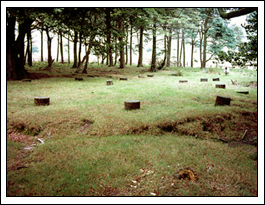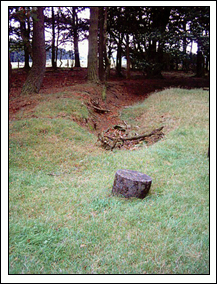Here’s a thought: “Was Bleasdale Circle really Norse?”
“Don’t be stupid!” echo the cries from the died-in-the-wool antiquarians. “It was constructed during the Bronze Age! It’s a known fact! You amateurs have no idea what you’re talking about!”
Really? Or have the experts (and not for the first time) got things wrong? (We said that the gloves were coming off this year and we’d be expecting a small barrage of e-mail complaints right about now if we actually believed that anybody ever read these postings.)
Okay…let’s start with the fact that the circle itself has never been scientifically dated. Following Shadrack Jackson’s excavations in the nineteenth century, the wooden stumps constituting the outer and inner circles were left on the ground beside their original holes. Naturally, it didn’t take long before they’d rotted.
No carbon dating there, then.
The only material that survived Jackson’s vandalism were several birch poles now housed in the Harris Museum. These have also never been tested and are now probably far too contaminated after a century of exposure to yield any reliable results.
To be honest, the only reason we ‘know’ that Bleasdale Circle was Bronze Age is because of the urns excavated from the central mound. Not that they were scientifically tested either. They were identified purely on the merits of their appearance.
Which is all very well and good except…well…at Claughton and Inskip, two Norse burials containing urns of a similar ilk (not to mention several Bronze Age weapons) were also discovered. We’ve mentioned them before, and with good reason because, apparently, the experts are still stumped as to what was going on. If it hadn’t been for the Viking artefacts buried alongside them, both internments would have been mistaken as Bronze Age. Some historians even today are still convinced that, by an umpteen-billion to one chance, both locations were occupied by burials separated by thousands of years.
Those of us who don’t believe in billion-to-one coincidences, however, have a different theory.
Before the Saxons arrived in Amounderness, the Norse and the local Celts were already trading, living side-by-side and intermarrying, not only their flesh but their religious practices.

“Don’t be stupid!” echo the cries from the died-in-the-wool antiquarians. “It was constructed during the Bronze Age! It’s a known fact! You amateurs have no idea what you’re talking about!”
Really? Or have the experts (and not for the first time) got things wrong? (We said that the gloves were coming off this year and we’d be expecting a small barrage of e-mail complaints right about now if we actually believed that anybody ever read these postings.)
Okay…let’s start with the fact that the circle itself has never been scientifically dated. Following Shadrack Jackson’s excavations in the nineteenth century, the wooden stumps constituting the outer and inner circles were left on the ground beside their original holes. Naturally, it didn’t take long before they’d rotted.
No carbon dating there, then.
The only material that survived Jackson’s vandalism were several birch poles now housed in the Harris Museum. These have also never been tested and are now probably far too contaminated after a century of exposure to yield any reliable results.
To be honest, the only reason we ‘know’ that Bleasdale Circle was Bronze Age is because of the urns excavated from the central mound. Not that they were scientifically tested either. They were identified purely on the merits of their appearance.
Which is all very well and good except…well…at Claughton and Inskip, two Norse burials containing urns of a similar ilk (not to mention several Bronze Age weapons) were also discovered. We’ve mentioned them before, and with good reason because, apparently, the experts are still stumped as to what was going on. If it hadn’t been for the Viking artefacts buried alongside them, both internments would have been mistaken as Bronze Age. Some historians even today are still convinced that, by an umpteen-billion to one chance, both locations were occupied by burials separated by thousands of years.
Those of us who don’t believe in billion-to-one coincidences, however, have a different theory.
Before the Saxons arrived in Amounderness, the Norse and the local Celts were already trading, living side-by-side and intermarrying, not only their flesh but their religious practices.

Admittedly this particular theory means rewriting the southern-centric, Saxon-driven history of Britain in some small way, but we’re not the first to suggest the hypothesis.
Here’s a quote from Porter’s ‘History of the Fylde’: “Bishop Turner affirms that ‘the lands in Amounderness, on the Ribble’ were first presented to a Culdee Abbott, named Eata….sometime before 661.”
Here’s a quote from Porter’s ‘History of the Fylde’: “Bishop Turner affirms that ‘the lands in Amounderness, on the Ribble’ were first presented to a Culdee Abbott, named Eata….sometime before 661.”
Amounderness was the Norse name for the district. Given that, according to conventional history, the Norse as a race didn’t exist until the tenth century, you can’t help wondering how Amounderness came by this particular epithet several centuries earlier.
Unless, of course, the experts are talking through their hats.
Let’s go with the idea for now that the pre-Saxon Wyre was inhabited by local Celts (practising their ancient druidic religion) and early Norse traders/settlers who were more than happy to follow suit. That would explain the Claughton and Inskip burials, as well as numerous other archaeological enigmas around the district.
But it also draws a question mark over the construction date of Bleasdale Circle; especially when you stop to consider that the name ‘Bleasdale’ itself comes from the Icelandic Norse word ‘Blesa’ meaning a ‘Blaze’ and, of course, ‘Dale’ meaning ‘a dale’.

Unless, of course, the experts are talking through their hats.
Let’s go with the idea for now that the pre-Saxon Wyre was inhabited by local Celts (practising their ancient druidic religion) and early Norse traders/settlers who were more than happy to follow suit. That would explain the Claughton and Inskip burials, as well as numerous other archaeological enigmas around the district.
But it also draws a question mark over the construction date of Bleasdale Circle; especially when you stop to consider that the name ‘Bleasdale’ itself comes from the Icelandic Norse word ‘Blesa’ meaning a ‘Blaze’ and, of course, ‘Dale’ meaning ‘a dale’.

As we’ve mentioned elsewhere, following its construction Bleasdale Circle was deliberately set alight, no doubt as part of the burial ritual. Thus the ‘Blaze in the Dale’ makes perfect sense.
The question is, if the circle had been constructed during the Bronze Age, how did the Norse, several thousand years later, know what had taken place there?
Okay…we’re not claiming with any certainty that Bleasdale Circle was constructed several thousand years later than the experts argue. It might well be, and probably is, a Bronze Age construction. It’s just that it might be worth considering possibilities from time to time other than the generally accepted ones.
Anybody who wants to argue the point can reach us through the usual channels; especially if you’ve made it your life’s work to analyse Bleasdale Circle and think that we’re talking utter drivel. (Trust us, you wouldn’t be the first.) We’d welcome the input if only to hear from ‘an expert’ for once, instead of always being ignored by them.
The question is, if the circle had been constructed during the Bronze Age, how did the Norse, several thousand years later, know what had taken place there?
Okay…we’re not claiming with any certainty that Bleasdale Circle was constructed several thousand years later than the experts argue. It might well be, and probably is, a Bronze Age construction. It’s just that it might be worth considering possibilities from time to time other than the generally accepted ones.
Anybody who wants to argue the point can reach us through the usual channels; especially if you’ve made it your life’s work to analyse Bleasdale Circle and think that we’re talking utter drivel. (Trust us, you wouldn’t be the first.) We’d welcome the input if only to hear from ‘an expert’ for once, instead of always being ignored by them.



















3 comments:
How can you doubt that anyone reads this column? I for one look forward to your gentle rambling... er, fascinating looks into the Wyre, and it's layers of history, each week. I urge other readers to leave comments as well, to show their support for one of the few blogs on the entire web that actually has original, interesting content.
I find it refreshing that you don't start every post with "Sorry I haven't posted in a while...", which seems to be the only words that amateur bloggers can come up with.
Anyways, you raise several interesting points here, but I have to display a bit of frustration that you don't seem to have any answers whatsoever about anything. :0)
I know... you're bringing up the Wyre's many mysteries, which are varies and interesting, but maybe you could throw us a bone one week and actually tell us some stuff that is written in stone. ( I know... 'bone', 'written in stone'... and no, I'm not looking for a rundown on who's who in your local cemetery. Unless you have some cool ghost stories, that is.)
Back to this week's post... haven't there been examples in the UK of burials on top of other burials, making for some interesting congruences?
Still, it's always good to challenge the status quo, particularly in cases where archeology was performed centuries past.
Cheers, and keep up the good work!
JOHN :0)
John...
"Haven't there been examples in the UK of burials on top of other burials?"
Not as far as I'm aware (although, of course, if there's anybody reading this who might know different then they could always drop us a line) and certainly none separated by several thousand years. There are, of course, mediaeval Christian burials surrounding churches built on Pagan burial mounds...but that's different. Pagen burial mounds became the sites of keeills for socio/political reasons, which in turn became Christian churches, so the evolution in those cases is pretty clear.
As for some concrete history (bones in stone? aren't they fossils?) you could always buy a copy of our 'History of the Wyre from Harold the Elk to Cardinal Allen) book (there's a link on the main page) but I'll see what I can do for a couple of weeks time. (I post these things well in advance, you see, in case of emergency, and then keep them hidden away until Friday nights.)
Actually... Have a look at some of the Orkney history - there are many examples up there of the Norse using older burial sites as their own. It's an exceptionally interesting place for someone from round Wyre/Fylde, as the dialect is very easily understood, the people are like those round here, and the history seems very similar as well. Also, one of the islands is called Wyre - we would have gone across but it was rather choppy and we were wusses! I recommend it as a holiday - planning Shetland at some point soon and hoping for some sort of similar experience!
Post a Comment